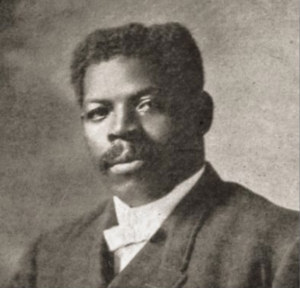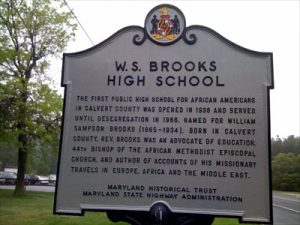Bishop William Sampson Brooks
William Brooks powerful leader, visionary, activist, author, humanitarian, and financier, believed in education and faith in his Lord.
May 15,1865- July,1939

Bishop William Sampson Brooks believed in equality for his race; his path to achieve it was hard work, education, determination, wealth-building, and belief in the Lord. He made remarkable contributions to the African Methodist Episcopal (AME) Church.
William Sampson Brooks, son of Robert and Margie Rebecca Brooks, grandson of Rebecca Banister, was born May 15,1865 in Lower Marlboro, Calvert County, Maryland. In his book, Footprints of a Black Man, Bishop Brooks wrote that his father “…was born of slave parents and experienced the many hardships that were the inevitable lot of my people in the dark days of slavery.”
When Brooks was 21, the Carrol Chapel Methodist Church sponsored his entrance into the Centenary Biblical Institute in Baltimore. He graduated in 1892. Brooks went on to a career as a minister, missionary and bishop. He served as pastor at African Methodist Episcopal Church (A.M.E). churches in nine states and in West Africa.
William Brooks was a man of many talents. He wrote and published books, established churches and saved other churches from foreclosure. From 1917 to 1920, as pastor at Bethel AME Church in Baltimore, he raised $55,000 to successfully liquidate Bethel’s debt. While traveling the world teaching, he taught himself 5 languages. During his eight years in West Africa, he built churches and schools.
In 1920, Brooks became the 44th Bishop of the AME Church. He died in July,1934 in San Antonio, Texas.
Brooks High School, built in 1938, the first public Black high school in Calvert County, was named in his memory. Central Colored High School was the first; it existed from 1929 to 1938 on Armory Road.
Did you know?
- When Brooks was born in 1865, the Calvert County population was majority Black: 6,450 African Americans and 3,994 whites.
- Centenary Bible Institute offered the first theological training of any kind for Blacks in Maryland and later became Morgan State College.
- Bishop Brooks was married to his first wife, Susan Williams Brooks for 33 years. In 1930, Brooks married the powerful civil rights organizer Elizabeth Carter of New Bedford, Massachusetts. Born to formerly enslaved parents, Mrs. Carter Brooks was an early member of the NAACP, an anti-lynching activist, women’s suffrage advocate, architect, and advocate for the aged.
Historical marker for Brooks High School
Additional Resources
Brooks, William S. Footprints of a Black Man in the Holy Land. Eden Publishing House, 1915. Footprints of a Black Man: The Holy Land – William Sampson Brooks – Google Books
Brooks, William S. What a Black Man Saw in a White Man’s Country: Some Account of a Trip to the Land of the Midnight Sun. Minneapolis, 1899. https://digital.library.emory.edu/catalog/279v15dwpq-cor Accessed 15 Aug 2023.
Brooks, Bishop W. Sampson. “Three Addresses: Beyond the Sea, At San Antonio Library, To White Methodists.” https://msa.maryland.gov/megafile/msa/speccol/sc5700/sc5774/000000/000009/000000/000005/pdf/sc5774-9-5.pdf. Accessed 11 July 2023.
Calvert Library. Inspiring African American Men of Calvert County, 2018. https://calvertlibrary.info/wp-content/uploads/2018/12/InspiringMenWordFinal.pdf.Accessed 6 June 2023.
“Dubois Lauds Bishop Brooks.” Afro-American, May 30, 1924.
Goodard, Richlyn F. Persistence, Perseverance and Power: History of African American Schools in Calvert County, Maryland 1865-1965. Maryland Humanities Council, 1995. Book.
“Great Leader and Organizer: Pastoral Record of Rev. W. Sampson Brooks, Believes in Co-operation,” Broad Ax, Salt Lake City, Utah, July 16, 1913.
Levy, Sidney and Lara Westwood. “The Rise of the African Methodist Episcopal Church in Baltimore and the Bethel A.M.E. Church.” Maryland Center for History and Culture https://www.mdhistory.org/the-rise-of-the-african-methodist-episcopal-church-in-baltimore-and-the-bethel-a-m-e-church/. Accessed 15 July 2023.
Maryland Historical Trust. “William Sampson Brooks High School.” Updated 2003. https://mht.maryland.gov/secure/medusa/PDF/Calvert/CT-1263.pdf
Wallace, Edith B. They Have Erected a Neat Little Church: A Special History Study of The Rural African American Experience, 1865-1900, in the National Capital Area. Organization of American Historians and The National Park Service, October 2020. https://irma.nps.gov/DataStore/DownloadFile/668575
WBAL-TV 11 Baltimore. “Morgan State University celebrates 150 years.” YouTube, 13 Feb. 2018.
